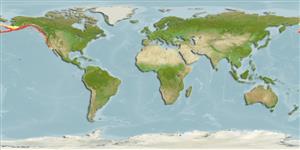Teleostei (teleosts) >
Pleuronectiformes (Flatfishes) >
Pleuronectidae (Righteye flounders) > Microstominae
Etymology: Microstomus: Greek, mikros = small + Greek, stoma = mouth (Ref. 45335).
Environment: milieu / climate zone / depth range / distribution range
Ecology
Marine; demersal; depth range 10 - 1370 m (Ref. 50610). Temperate; 65°N - 31°N, 178°E - 117°W
Eastern Pacific: Navarin Canyon in the Bering Sea to Stalemate Bank in the Aleutian Islands and San Cristobal Bay, Baja California, Mexico.
Length at first maturity / Size / Weight / Age
Maturity: Lm 38.5, range 38 - 40 cm
Max length : 76.0 cm TL male/unsexed; (Ref. 2850); common length : 40.0 cm TL male/unsexed; (Ref. 56527); max. published weight: 3.5 kg (Ref. 56527); max. reported age: 56 years (Ref. 74500)
Adults occur on mud bottom (Ref. 2850). They move into deep water in winter (Ref. 2850). Produce large amounts of slime which may cover other fishes when caught in trawls (Ref. 4925). Marketed as mink food (Ref. 4925) or as fillet (Ref. 2850).
Vinnikov, K.A., R.C. Thomson and T.A. Munroe, 2018. Revised classification of the righteye flounders (Teleostei: Pleuronectidae) based on multilocus phylogeny with complete taxon sampling. Molecular phylogenetics and evolution, 125:147-162. (Ref. 122998)
IUCN Red List Status (Ref. 130435: Version 2024-1)
Threat to humans
Harmless
Human uses
Fisheries: commercial; gamefish: yes
Tools
Special reports
Download XML
Internet sources
Estimates based on models
Preferred temperature (Ref.
123201): 1.1 - 6.3, mean 3.5 °C (based on 248 cells).
Phylogenetic diversity index (Ref.
82804): PD
50 = 0.5625 [Uniqueness, from 0.5 = low to 2.0 = high].
Bayesian length-weight: a=0.00646 (0.00367 - 0.01135), b=3.07 (2.91 - 3.23), in cm total length, based on LWR estimates for this species & (Sub)family-body (Ref.
93245).
Trophic level (Ref.
69278): 3.2 ±0.1 se; based on diet studies.
Resilience (Ref.
120179): Low, minimum population doubling time 4.5 - 14 years (tm=5; tmax=56; K=0.26; Fec=37,000).
Prior r = 0.29, 95% CL = 0.19 - 0.44, Based on 2 full stock assessments.
Fishing Vulnerability (Ref.
59153): High to very high vulnerability (71 of 100).
Climate Vulnerability (Ref.
125649): Moderate vulnerability (43 of 100).
Nutrients (Ref.
124155): Calcium = 14.7 [8.7, 29.4] mg/100g; Iron = 0.211 [0.121, 0.389] mg/100g; Protein = 16.7 [14.7, 18.8] %; Omega3 = 0.337 [0.163, 0.715] g/100g; Selenium = 27.8 [13.8, 59.9] μg/100g; VitaminA = 7.77 [1.73, 33.10] μg/100g; Zinc = 0.373 [0.269, 0.554] mg/100g (wet weight); based on
nutrient studies.
